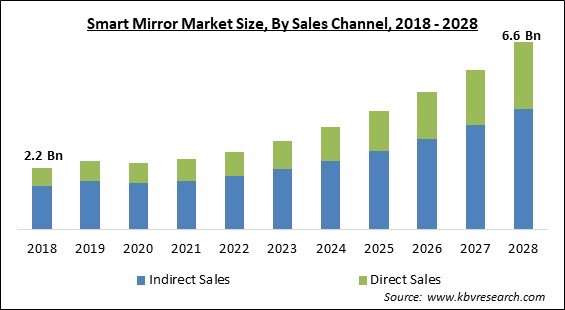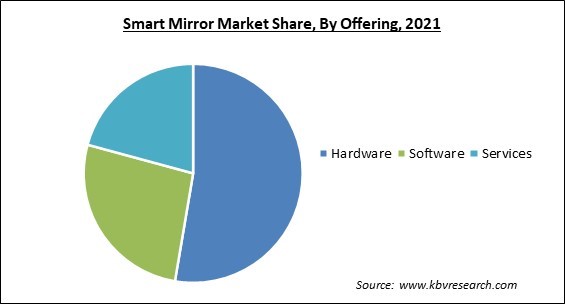The Global Smart Mirror Market size is expected to reach $6.6 billion by 2028, rising at a market growth of 15.8% CAGR during the forecast period.
A smart mirror is a sophisticated mirror equipped with cameras, displays, sensors, and connectivity tools. Major applications for these mirrors include the automotive, residential, healthcare, retail, and other sectors of the economy. Depending on their utility, smart mirrors can perform a variety of different tasks. Smart mirrors can also be utilized as side & rearview mirrors in the automotive industry for increased safety. Smart mirrors are also utilized in the retail industry to suggest fashionable outfits to customers.

Smart displays and digital mirrors are other names for smart mirrors. Gesture recognition, artificial intelligence, and augmented reality are all used in smart mirrors. Fitting rooms will be obsolete due tto the convergence of these technologies and smart mirrors that can overlay clothing on a person's image. Smart mirrors connect to the user's phone through Bluetooth or Wi-Fi and have a digital display hidden behind the glass. Depending on the usage type, end-user profile, and location, they perform very different functions.
The increasing use of smart mirrors as an alternative to convex mirrors for improved safety features in automobiles, rising demand for smart homes, the presence of numerous startups, as well as unique features of smart mirrors are some of the other major drivers of the market growth for these products. Numerous trade shows as well as expos have helped manufacturers of smart mirrors grow their clientele and significantly fuel the market for smart mirrors. To enhance the safety of the driver & passengers, the smart rearview mirror was introduced on the market. The tool has a display screen so that the driver can see their blind spot in various situations. The driver also has the option of switching between the monitor & traditional view on the screen.
Numerous IoT devices are anticipated to provide a more comfortable work/study environment after and during a pandemic as more people choose to work and study from home. In the post-COVID era, the home would mean something different to consumers: it would be a place for entertainment, work, and study. Families are therefore increasingly looking for goods and services that improve quality of life and make life more comfortable and meaningful. These factors have created a sizable market for home furnishings and smart home technologies and thus the market for smart mirrors is expected to grow.
Autos with smart mirrors installed play a significant role in ensuring comfort and safety while driving. The electro-chromatic auto-dimming mirror found in high-end vehicle smart mirrors reduces driver eye strain and fatigue while improving visibility in low light. By providing better rear-view images that aid drivers in making safe decisions while driving, these mirrors promote safety. Furthermore, by providing drivers with all the information they need to know on the mirror screen, these smart mirrors save time. Smart mirrors have the ability to detect & alert users to moving objects in addition to automatically correcting camera distortion.
Digital retailers and physical stores are combining, transforming the retail sector. Businesses are embracing new approaches to management and re-engineering customer interactions. Retailers are incorporating a range of technologies, including smart shelves, retail robots, smart mirrors, and smart carts. This industry is presently going through a quick change from conventional brick-and-mortar retail stores to cutting-edge digital retail stores where technology plays a critical role in increasing customer engagement and revenue for retailers. Consequently, the market for smart mirrors is expanding as a result of traditional stores becoming digital stores.
Due to the tracking of users' personal information by smart mirrors, the security breach is one of the main impediments. For instance, smart mirrors installed in retail locations can easily monitor customer purchasing behaviors and spending patterns. The smart mirrors can also access other crucial consumer data, including past purchase histories, frequent interactions with store associates, and hundreds of other data points pertaining to customer behavior and purchasing preferences. By running sales & marketing campaigns based on consumers' past purchasing interests, retailers can use the data they have collected to target the right customers for selling products to in the future. As a result, the market's growth over the projected period may be hampered by growing concerns over personal data security.
Based on Offering, the smart mirror market is segmented into hardware (displays, cameras, sensors, others); software and services. The software segment acquired a significant revenue share in the smart mirror market in 2021. A technology-driven smart mirror provides a number of advantages because it uses software to conduct intelligent operations. The user can use it as a personal assistant by having it provide the necessary crucial and current information. Additionally, it uses voice control and faces recognition technology, which can provide the fashion & cosmetics industries with an effective user interface.

On the basis of application, the smart mirror market is fragmented into automotive, retail, residential, hospitality, healthcare and others. In 2021, the automotive segment held the largest revenue share in the smart mirror market. This is because of the widespread use of digital rear-view mirrors in automobiles. The market is expanding as a result of the increasing popularity of mirrorless vehicles and the adoption of display mirrors built around smart cameras. Approximately 30 percent of high-end vehicles currently on the road have inside mirrors with built-in electrochromic technology, compared to 10 to 15 percent of outside mirrors.
By technology, the smart mirror market is divided into electro chromatic and others. In 2021, the electro-chromatic segment witnessed the highest revenue share in the smart mirror market. The market for electro-chromatic smart mirrors is being driven by numerous benefits that digital rear-view smart mirrors have over conventional mirrors. The vast bulk of digital rear-view mirrors is equipped with an integrated camera mounted on the back of the vehicle and an electro-chromatic rear-view mirror.
Based on sales channel, the smart mirror market is classified into direct sales, and indirect sales. The indirect sales segment procured a significant revenue share in the smart mirror market in 2021. Indirect sales channels could be a great way to encourage indirect sellers to take up the product or service, but they can also lead to channel conflict and other problems. A company may utilize indirect sales in place of hiring or in addition to direct sales efforts. This would further increase the sale of companies. As a result, the smart mirror market would grow in this segment.
On the basis of installation type, the smart mirror market is bifurcated into fixed, and free style. The freestyle segment covered a substantial revenue share in the smart mirror market in 2021. The freestyle smart mirrors are comparatively fast and also the images can be replaced easily in these mirrors. The demand for smart mirrors in this segment is increasing as a result of the growing demand for home automation. Also, as the retail stores across the globe are growing the adoption of smart mirrors would increase in the upcoming years.
| Report Attribute | Details |
|---|---|
| Market size value in 2021 | USD 2.5 Billion |
| Market size forecast in 2028 | USD 6.6 Billion |
| Base Year | 2021 |
| Historical Period | 2018 to 2020 |
| Forecast Period | 2022 to 2028 |
| Revenue Growth Rate | CAGR of 15.8% from 2022 to 2028 |
| Number of Pages | 313 |
| Number of Tables | 630 |
| Report coverage | Market Trends, Revenue Estimation and Forecast, Segmentation Analysis, Regional and Country Breakdown, Companies Strategic Developments, Company Profiling |
| Segments covered | Sales Channel, Offering, Technology, Installation Type, Application, Region |
| Country scope | US, Canada, Mexico, Germany, UK, France, Russia, Spain, Italy, China, Japan, India, South Korea, Singapore, Malaysia, Brazil, Argentina, UAE, Saudi Arabia, South Africa, Nigeria |
| Growth Drivers |
|
| Restraints |
|
Region wise, the smart mirror market is analyzed across North America, Europe, Asia Pacific and LAMEA. In 2021, the Europe segment led the smart mirror market with the largest revenue share. A few of the primary drivers of market growth in Europe are the region's growing use of electric vehicles (EVs) and the focus on automation across a range of end-use industries, including the automotive & retail sectors. The region has a high demand for rear-view mirrors as a result of the presence of numerous auto manufacturers. The region is renowned for its strict safety laws and cutting-edge technology.
Free Valuable Insights: Global Smart Mirror Market size to reach USD 6.6 Billion by 2028
The market research report covers the analysis of key stake holders of the market. Key companies profiled in the report include Murakami Corporation, Japan Display, Inc., Gentex Corporation, Magna International, Inc., Harman International Industries, Inc. (Samsung Electronics Co., Ltd.), Seura Solutions, ad notam AG, Dension Kft., Keonn Technologies, and Ficosa International, S.A.
By Sales Channel
By Offering
By Technology
By Installation Type
By Application
By Geography
The global Smart Mirror Market size is expected to reach $6.6 billion by 2028.
Convex mirror replacement for improved safety features in cars are driving the market in coming years, however, Data breaches involving sensitive & private information restraints the growth of the market.
Murakami Corporation, Japan Display, Inc., Gentex Corporation, Magna International, Inc., Harman International Industries, Inc. (Samsung Electronics Co., Ltd.), Seura Solutions, ad notam AG, Dension Kft., Keonn Technologies, and Ficosa International, S.A.
The expected CAGR of the Smart Mirror Market is 15.8% from 2022 to 2028.
The Hardware market acquired the highest revenue share in the Global Smart Mirror Market by Offering in 2021, thereby, achieving a market value of $3.4 billion by 2028.
The Europe market dominated the Global Smart Mirror Market by Region in 2021, and would continue to be a dominant market till 2028; thereby, achieving a market value of $2.1 billion by 2028.
Our team of dedicated experts can provide you with attractive expansion opportunities for your business.

